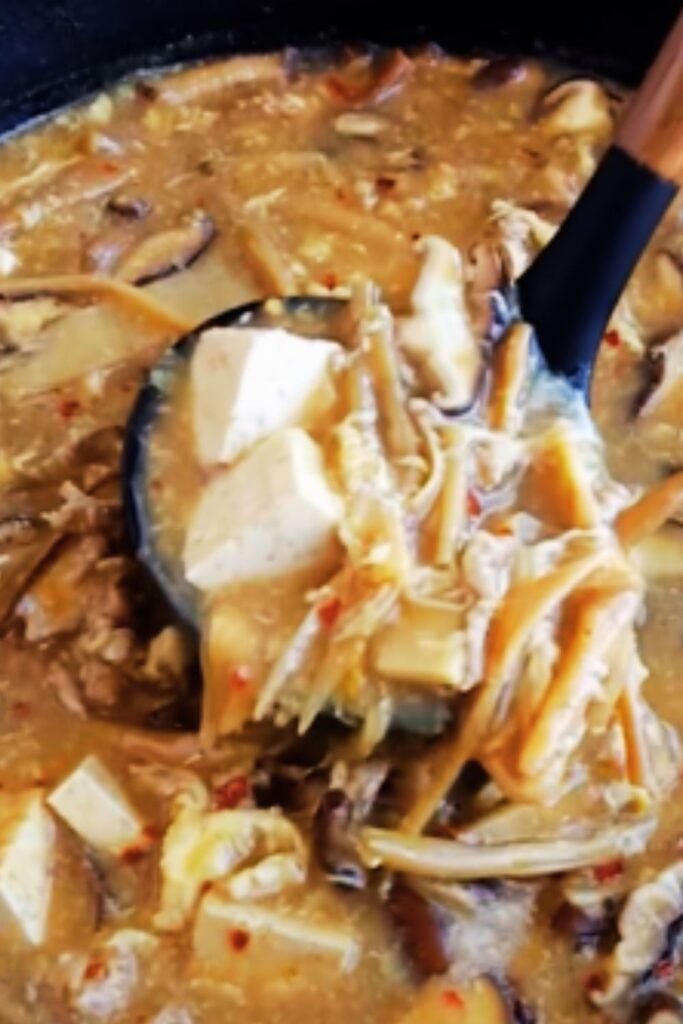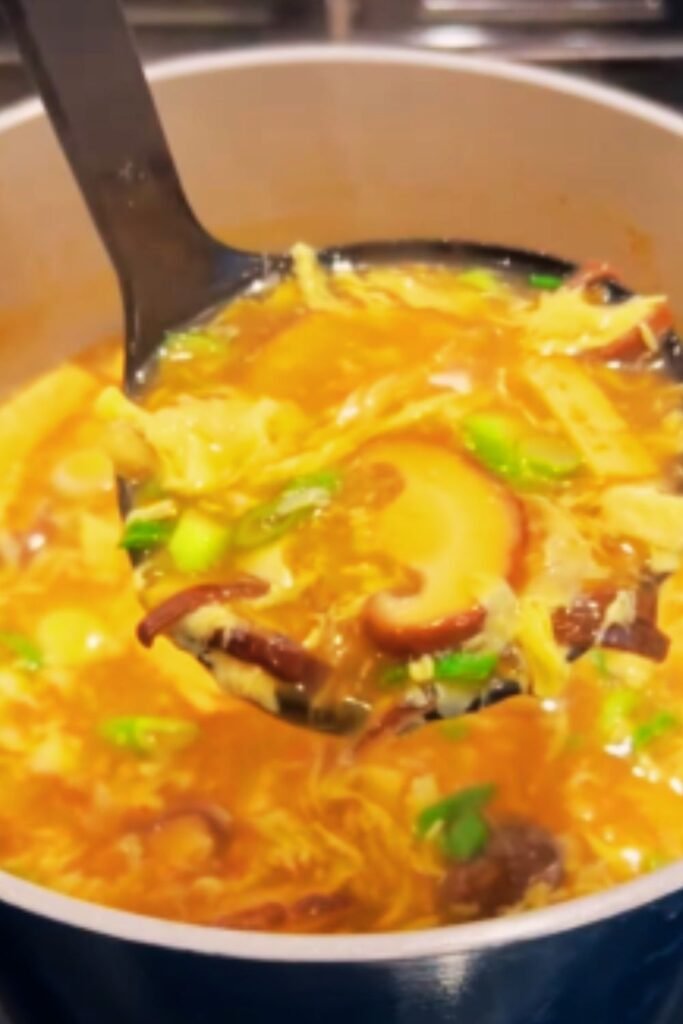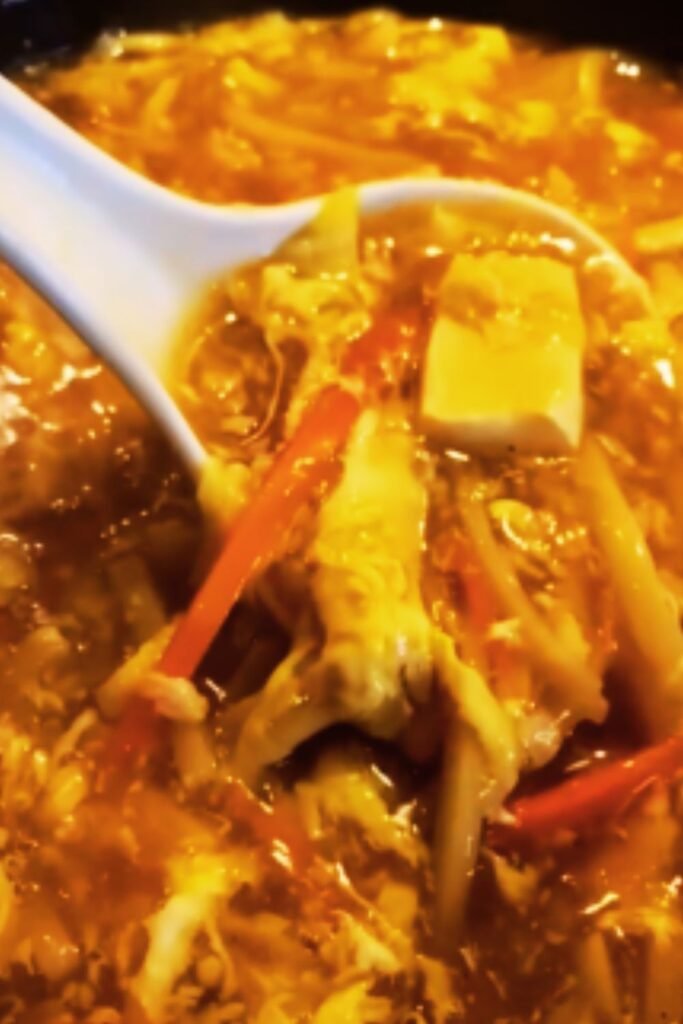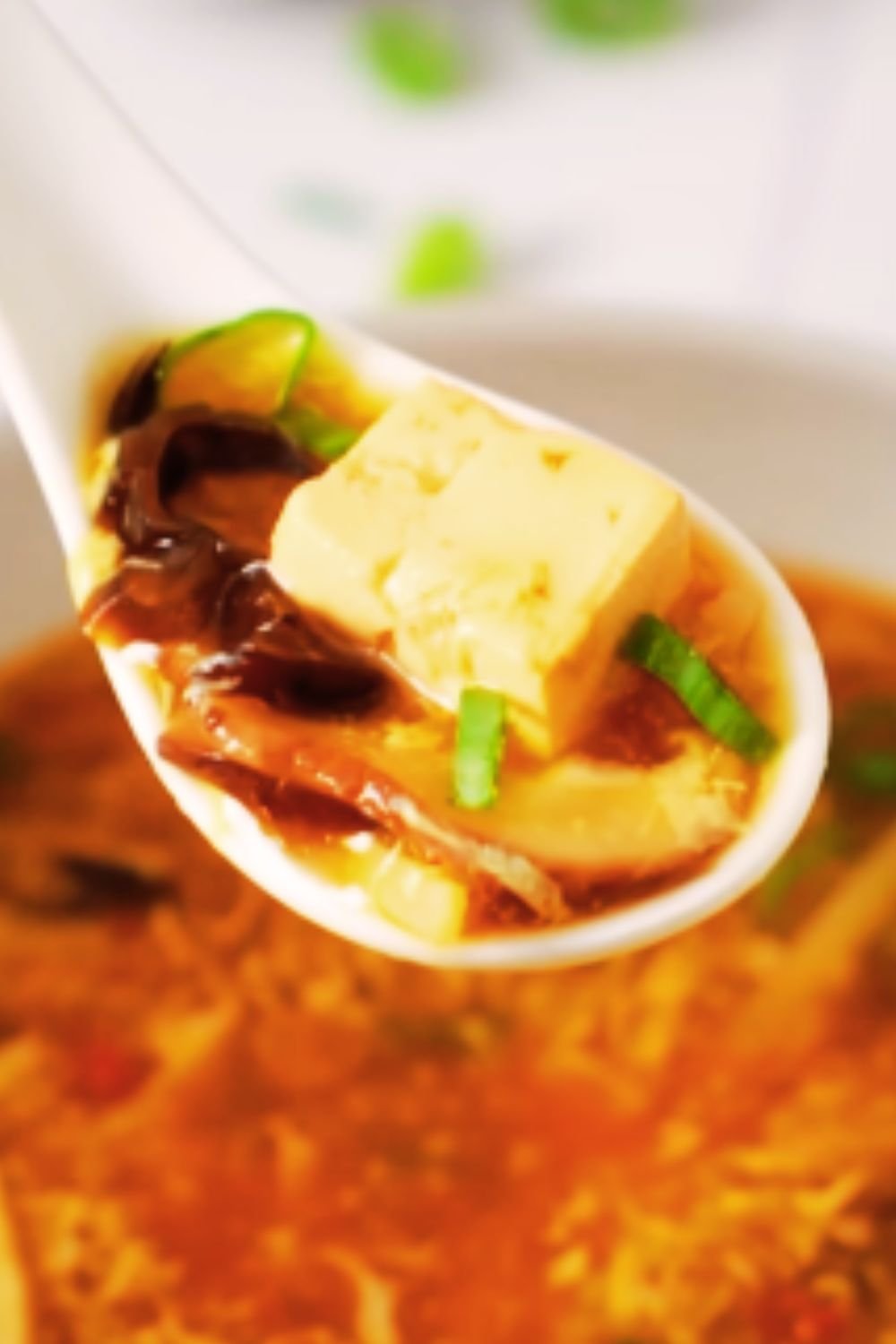I’ve been making Hot & Sour Soup for over fifteen years, and I can confidently say it’s one of those dishes that never fails to impress. Whether you’re battling a cold, craving something warming on a chilly evening, or simply want to recreate that authentic Chinese restaurant experience at home, this 30-minute recipe delivers every single time.
The beauty of Hot & Sour Soup lies in its perfect balance of contrasting flavors. The “hot” comes from white pepper and chili oil, while the “sour” emerges from rice vinegar and sometimes a touch of lime. But what makes this soup truly special is the silky texture created by beaten eggs and the satisfying chewiness of wood ear mushrooms and tofu.
What Makes This Recipe Special
My version cuts down the traditional cooking time without sacrificing any of the complex flavors that make this soup so beloved. I’ve spent countless hours perfecting the technique for creating those gorgeous egg ribbons that float through the broth like silken clouds. The secret lies in the temperature control and the way you pour the beaten eggs into the soup.
This isn’t just another quick soup recipe – it’s a carefully crafted balance of textures and flavors that rivals any restaurant version. I use a combination of both light and dark soy sauce for depth, and my special trick is adding the cornstarch slurry in two stages for the perfect consistency.
Essential Ingredients Breakdown
Protein Components:
- Firm tofu (14 oz block) – provides substance and absorbs flavors beautifully
- Eggs (3 large) – creates those signature wispy ribbons
- Optional: thinly sliced pork or chicken (4 oz)
Mushroom Varieties:
- Dried wood ear mushrooms (1 oz) – essential for authentic texture
- Fresh shiitake mushrooms (4 oz) – adds meaty umami depth
- Dried lily buds (optional but traditional) – sweet, earthy flavor
Flavor Foundation:
- Chicken or vegetable broth (6 cups) – use good quality stock
- Rice vinegar (3-4 tablespoons) – the key sour element
- White pepper (1-2 teaspoons) – provides the heat
- Light soy sauce (2 tablespoons) – for saltiness and color
- Dark soy sauce (1 tablespoon) – for deeper color and richness
Texture Enhancers:
- Cornstarch (3 tablespoons) – for thickening
- Sesame oil (2 teaspoons) – finishing touch
- Chili oil (1-2 teaspoons) – additional heat and flavor

Step-by-Step Cooking Method
Preparation Phase (10 minutes):
First, I soak my dried wood ear mushrooms in warm water for about 20 minutes until they’re fully rehydrated. They’ll expand significantly, so don’t be surprised when that small handful becomes a generous cup of mushrooms. While they’re soaking, I slice my tofu into thin strips about 2 inches long and ¼ inch thick.
The key to great tofu in this soup is the cutting technique. I pat the tofu completely dry with paper towels, then use a sharp knife to create clean cuts. Ragged edges will break apart during cooking, creating a muddy appearance in your beautiful clear broth.
Next, I prepare my egg mixture. I beat three large eggs thoroughly with a fork until they’re completely smooth. No lumps allowed here – those would create chunky bits instead of the silky ribbons we’re after.
Building the Broth (8 minutes):
I start by heating my broth in a large pot over medium-high heat. While it’s warming, I create my cornstarch slurry by mixing 3 tablespoons of cornstarch with 4 tablespoons of cold water. This mixture needs to be completely smooth – I whisk it until there are no lumps whatsoever.
Once my broth reaches a gentle simmer, I add the rehydrated mushrooms (drained and roughly chopped), the fresh shiitake mushrooms (sliced), and the tofu strips. I let this simmer for about 3 minutes to allow the flavors to meld.
Seasoning Balance (5 minutes):
Here’s where the magic happens. I add the soy sauces first – both light and dark – followed by half of my rice vinegar. I taste and adjust at this point, keeping in mind that the flavors will intensify as the soup continues to cook.
The white pepper goes in next, and I’m generous with it. This soup should have a noticeable peppery heat that builds as you eat. I start with one teaspoon and add more to taste.
Creating the Perfect Texture (7 minutes):
I stir in about two-thirds of my cornstarch slurry, whisking constantly to prevent lumps. The soup should thicken noticeably but still flow freely. If it seems too thin, I add the remaining slurry a little at a time.
Now comes the most crucial step – adding the eggs. I bring the soup to a rolling boil, then reduce the heat to medium. Using a fork, I slowly drizzle the beaten eggs into the soup in a thin stream while stirring gently in one direction. This creates those beautiful egg ribbons that make the soup so visually appealing.
Final Touches:
I remove the pot from heat and immediately stir in the remaining rice vinegar, sesame oil, and chili oil. The residual heat is perfect for melding these finishing flavors without cooking them harshly.

Nutritional Information and Health Benefits
| Nutrient | Per Serving (1 cup) | Daily Value % |
|---|---|---|
| Calories | 145 | 7% |
| Protein | 12g | 24% |
| Carbohydrates | 8g | 3% |
| Fat | 7g | 11% |
| Fiber | 2g | 8% |
| Sodium | 890mg | 39% |
| Vitamin C | 15mg | 17% |
| Iron | 2.1mg | 12% |
| Calcium | 85mg | 8% |
Health Benefits:
The ingredients in Hot & Sour Soup offer numerous health advantages. Tofu provides complete protein and isoflavones, which may help reduce cholesterol levels. Wood ear mushrooms are rich in iron and have been traditionally used to support blood health in Chinese medicine.
The white pepper doesn’t just add heat – it contains piperine, which may aid digestion and has anti-inflammatory properties. Rice vinegar can help stabilize blood sugar levels and may promote better nutrient absorption.
The eggs contribute high-quality protein and choline, essential for brain health. Even the modest amount of vegetables adds valuable vitamins and minerals to your diet.
Ingredient Substitutions and Variations
| Original Ingredient | Substitution Options | Notes |
|---|---|---|
| Wood ear mushrooms | Button mushrooms, cremini | Texture will differ but flavor remains good |
| Rice vinegar | Apple cider vinegar, white vinegar | Use slightly less as these are more acidic |
| Firm tofu | Silken tofu, tempeh | Silken tofu is more delicate; tempeh adds nuttiness |
| White pepper | Black pepper, cayenne | White pepper is preferred for authentic flavor |
| Chicken broth | Vegetable broth, mushroom broth | Vegetable broth keeps it vegetarian |
| Cornstarch | Arrowroot powder, potato starch | Use same amount, mix well |
Dietary Modifications:
For a vegan version, I simply omit the eggs and use vegetable broth instead of chicken broth. The soup loses some richness but gains a cleaner, more focused flavor profile.
If you’re watching sodium intake, use low-sodium broth and reduce the soy sauce by half. You can compensate with additional rice vinegar and a pinch of salt to taste.
For a protein boost, I sometimes add thinly sliced pork or chicken breast. Add these raw ingredients to the simmering broth about 5 minutes before the eggs, ensuring they cook through completely.
Troubleshooting Common Issues
Problem: Soup is too thick Solution: Add hot broth gradually while stirring until desired consistency is reached
Problem: Eggs formed chunks instead of ribbons Solution: Ensure soup is at a rolling boil and pour eggs very slowly while stirring
Problem: Not sour enough Solution: Add rice vinegar gradually after removing from heat to prevent harsh flavors
Problem: Too salty Solution: Add more rice vinegar and a pinch of sugar to balance the flavors
Problem: Lacks depth of flavor Solution: Check that you’re using both light and dark soy sauce; add more white pepper
Storage and Reheating Guidelines
| Storage Method | Duration | Quality Notes |
|---|---|---|
| Refrigerator | 3-4 days | Best consumed within 2 days |
| Freezer | Not recommended | Texture degrades significantly |
| Room temperature | 2 hours maximum | Food safety concern beyond this |
When reheating, I add a splash of broth or water since the cornstarch will continue to thicken the soup as it sits. I heat it gently over medium-low heat, stirring frequently to prevent sticking.
The flavors actually improve after sitting overnight, but the texture is best when fresh. If the soup seems too sour after storage, I add a tiny pinch of sugar to balance the flavors.

Serving Suggestions and Pairings
Hot & Sour Soup works beautifully as both an appetizer and a main course. As an appetizer, I serve it in small bowls alongside other Chinese dishes like spring rolls or dumplings. As a main course, I pair it with steamed rice and perhaps a simple stir-fried vegetable.
Complementary Dishes:
- Steamed pork or vegetable dumplings
- Chicken lettuce wraps
- Beef and broccoli stir-fry
- Ma po tofu
- Fried rice variations
- Fresh spring rolls
Garnish Options:
- Thinly sliced green onions
- Fresh cilantro leaves
- A drizzle of additional chili oil
- Toasted sesame seeds
- Thin cucumber julienne for crunch
Cultural Background and Regional Variations
Hot & Sour Soup originated in the Sichuan province of China, where the combination of spicy and sour flavors is fundamental to the regional cuisine. However, the version most familiar to Western palates actually comes from Northern Chinese cooking traditions.
In Sichuan, the soup tends to be much spicier, often incorporating Sichuan peppercorns for their distinctive numbing quality. The Northern version, which my recipe is based on, focuses more on the interplay between sour and peppery hot flavors.
Different regions add their own touches. Some areas include bamboo shoots for crunch, while others might add a touch of sugar to balance the acidity. Thai versions often include lemongrass and galangal, creating an entirely different but equally delicious soup.
Advanced Tips for Perfect Results
Temperature Control: The key to silky egg ribbons is maintaining the right temperature. Too low, and the eggs won’t set properly. Too high, and they’ll become tough and chunky.
Seasoning Strategy: I always season in stages. Initial seasoning goes in with the mushrooms, allowing time for the flavors to develop. Final seasoning happens off the heat to preserve the bright, fresh notes.
Texture Balance: The perfect Hot & Sour Soup has multiple textures – silky eggs, chewy mushrooms, tender tofu, and a slightly thickened broth. Each element should be distinct but harmonious.
Umami Development: Using both light and dark soy sauce isn’t just about color. The light soy provides saltiness and clean soy flavor, while the dark soy adds deeper, more complex notes and that beautiful amber color.
Questions and Answers
Q. Can I make this soup ahead of time for meal prep? I don’t recommend making the full soup ahead because the eggs and tofu can become tough when reheated. However, I often prepare the mushroom and broth mixture up to 2 days in advance, then add the eggs and final seasonings when ready to serve.
Q. Why is my soup not thick enough even after adding cornstarch? The cornstarch needs to be mixed with cold liquid first to prevent lumps, and the soup must come to a boil for the starch to activate properly. If it’s still thin, make another small slurry with 1 tablespoon cornstarch and 2 tablespoons cold water, then stir it in gradually.
Q. Can I use other types of vinegar instead of rice vinegar? Rice vinegar has a milder, slightly sweet flavor that works best in this soup. Apple cider vinegar can work as a substitute, but use about 25% less since it’s more acidic. Avoid white vinegar as it can be too harsh.
Q. What’s the difference between white pepper and black pepper in this recipe? White pepper has a different flavor profile – it’s more purely spicy without the earthy notes of black pepper. It also doesn’t create black specks in the soup, maintaining the clean appearance. The heat from white pepper builds more gradually and feels different on the palate.
Q. How can I make this soup spicier without changing the other flavors? Add more white pepper gradually – it’s the traditional way to increase heat in this soup. You can also add chili oil or a small amount of sriracha, but these will change the flavor profile slightly.
Q. My wood ear mushrooms are still tough after soaking. What went wrong? Wood ear mushrooms need warm (not hot) water and at least 20 minutes of soaking time. If they’re still tough, they may be old or poor quality. Try extending the soaking time to 30 minutes, or simmer them in the broth for a few extra minutes.
Q. Can I freeze leftover soup? I don’t recommend freezing Hot & Sour Soup because the texture changes dramatically. The eggs become rubbery, the tofu becomes spongy, and the overall consistency becomes grainy. It’s best consumed fresh or within 3 days from the refrigerator.
Q. How do I prevent the tofu from breaking apart in the soup? Use firm or extra-firm tofu, drain it well, and cut it with a sharp knife using gentle sawing motions rather than pressing down. Add it to gently simmering (not boiling) soup and stir minimally once it’s in the pot.
Q. Is this soup gluten-free? Traditional soy sauce contains wheat, so the soup isn’t gluten-free as written. However, you can substitute tamari or gluten-free soy sauce to make it suitable for those avoiding gluten. Check that your broth is also gluten-free.
Q. What’s the best way to reheat leftover soup without ruining the texture? Reheat gently over medium-low heat, stirring frequently. Add a splash of broth or water since the soup will have thickened. Don’t bring it to a hard boil, as this can make the eggs tough and break down the other ingredients.
This Hot & Sour Soup recipe has become a staple in my kitchen because it delivers restaurant-quality results in just 30 minutes. The combination of planning, technique, and quality ingredients creates something truly special – a soup that’s both comforting and exciting, familiar yet exotic. Every spoonful offers a different combination of textures and flavors, making it a dish that never gets boring.
The versatility of this recipe means you can adapt it to your preferences and dietary needs while maintaining the essential character that makes Hot & Sour Soup so beloved. Whether you’re making it for a quick weeknight dinner or as part of a larger Chinese feast, this soup will always deliver satisfaction and warmth.
